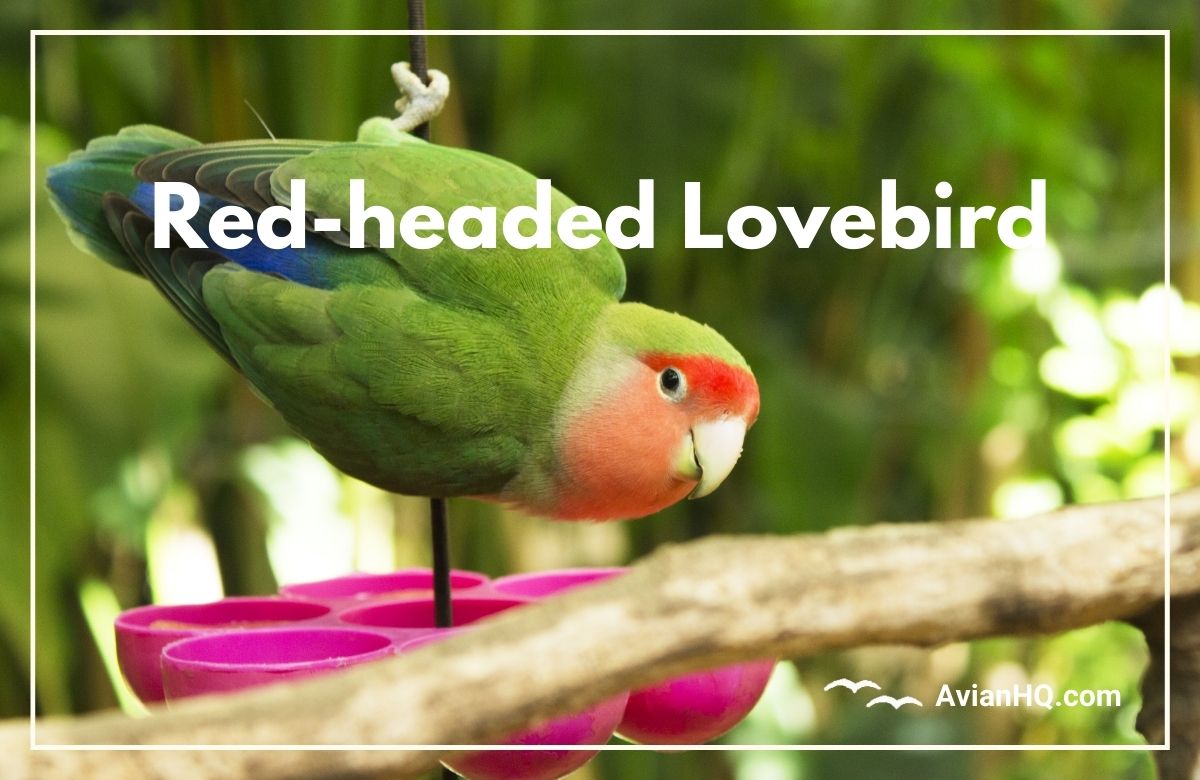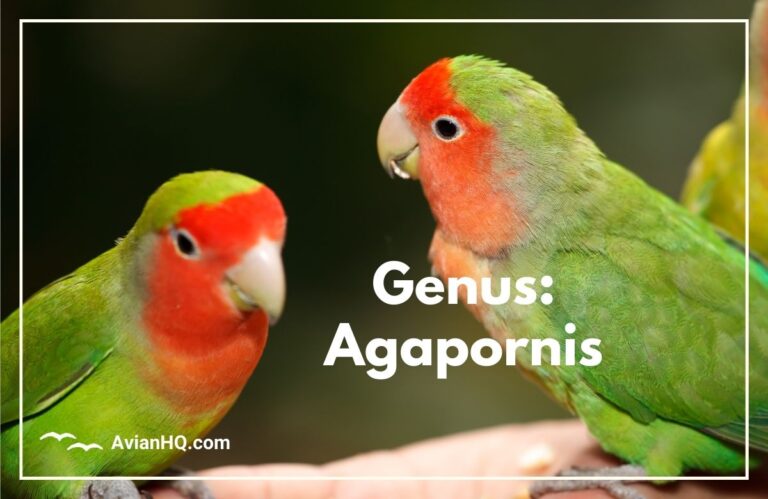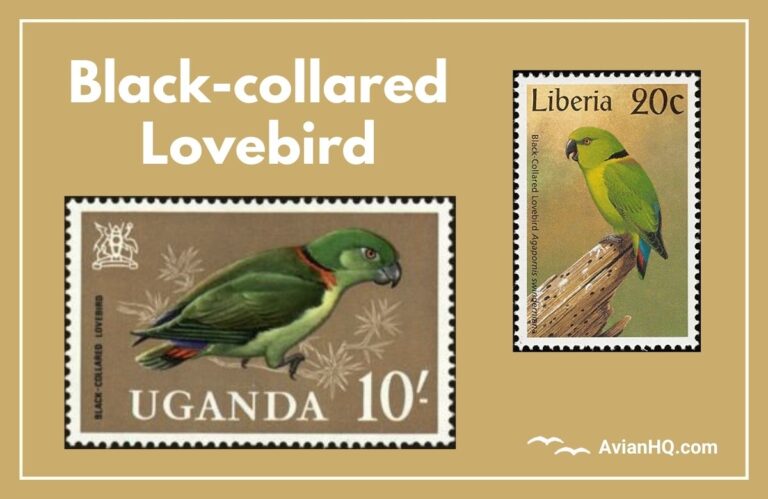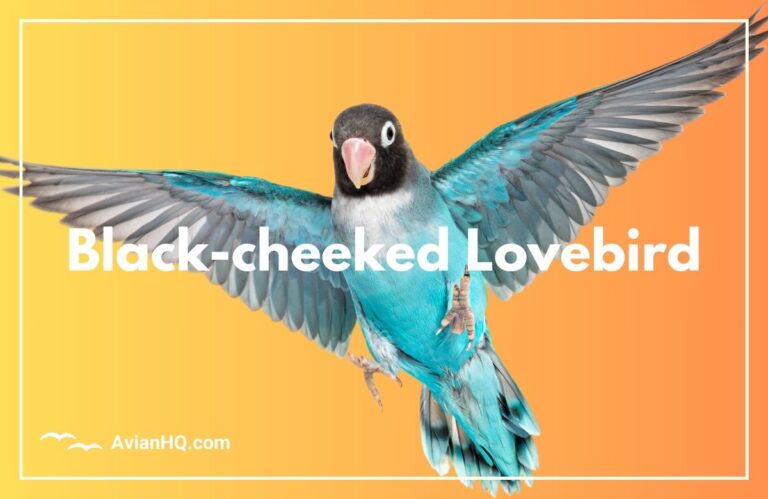Red-headed Lovebird (Agapornis pullarius)
You gaze out over the African savanna and spot a flash of green and red feathers flying by. A flock of vibrant little parrots with bright red faces are feasting on grass seeds before returning to their roosts for the evening. These are Red-headed Lovebirds, captivating little parrots native to the lush forests and savannas of Western and Central Africa.
With their striking red facial masks and high-energy disposition, Red-headed Lovebirds have charmed bird enthusiasts for centuries. First described scientifically by Carl Linnaeus in 1758, very little has changed in their natural ranges and behaviors over the years.
These petite parrots reach approximately 6 inches (15 cm) in length and 1.5 ounces (43 grams) in weight. Beyond the male’s trademark red face, both sexes sport primarily green plumage on their backs and wings, with some light blue and red marking on the rump and tail. The female is distinguished by her slightly less vivid orange facial mask.
Though seldom seen in the pet trade these days, the Red-headed Lovebird still maintains popularity due to its fierce loyalty to its mate and high-energy antics. When kept in captivity, these little characters need an aviary with ample space to zoom around and tunnel through cardboard tubes. Their demanding personality and specific nesting requirements make them ill-suited to novice bird owners.
Right now, Red-headed Lovebird populations remain stable across Western and Central Africa. However, their energetic disposition and striking colors continue to attract the attention of illegal trappers across their range. We’ll take an in-depth look at the natural history, conservation status, and captive care recommendations for these little African firecracker parrots.
History and Taxonomy
The origins of the Red-headed Lovebird stretch back hundreds of years in the tropical forests and savannas of Africa. These petite parrots with vivid red facial masks have captured the fascination of the western world since their discovery.
First Described by Carl Linnaeus in 1758
The first scientific description of the Red-headed Lovebird came from the legendary Carl Linnaeus in 1758. As the father of modern taxonomy, Linnaeus pioneered the two-name binomial naming system still used today. He categorized theRed-headed Lovebird within the parrot genus Psittacus and gave it the species name pullarius. This species name derives from the Latin word for “young bird.”
Today, the Red-headed Lovebird resides within its own genus Agapornis along with eight other miniature affectionate parrots. The term Agapornis combines the Greek words for love (agape) and bird (ornis). This nods to the strong bonds that lovebird pairs form with one another.
Two Subspecies with Different Distributions
Scientists recognize two subspecies of the Red-headed Lovebird, each occupying their own regions of Africa:
- A. p. pullarius – Ranges from Guinea and Sierra Leone eastward to Sudan, Democratic Republic of Congo, and Angola
- A. p. ugandae – Occupies central Ethiopia eastward to Uganda and Tanzania
The nominate A. p. pullarius claims the larger geographic distribution across Central and West Africa. The A. p. ugandae subspecies differentiated over time after becoming geographically separated farther inland. These two subgroups show subtle variances in the vibrancy of their plumage and markings.
Overall though, the similarities between the subspecies’ appearance and behaviors outweigh their differences. Their shared traits and adaptations continue to help them thrive among the seeds and fruits across their disparate African habitats.
Physical Appearance
The Red-headed Lovebird’s name offers a hint to its most distinctive feature – a vibrant red or orange facial mask. But this petite African parrot shows much more to its look beyond its colorful face.
Small Parrot Reaching 6 inches (15 cm) Long
As their name implies, Red-headed Lovebirds fall on the diminutive side for parrots. These compact birds reach an average body length of about 6 inches (15 centimeters) from the tip of the beak to the end of the tail. Other physical features include:
- Weight: Around 1.5 ounces (43 grams) on average
- Wingspan: Roughly 8-9 inches (20-22 cm)
Their tiny stature allows them to zip through treetops and tunnel into nesting cavities with ease. It also lets them flock together in large fast-moving groups up to 30 birds without chaos.
Vibrant Green Plumage with Splashes of Red, Orange, and Blue
Males sport bright grass green feathers across most of their body, including the:
- Back
- Chest
- Wings
- Top of the head
This verdant plumage transitions into a vivid orange-red facial mask that covers the:
- Forehead
- Cheeks
- Chin
Females also wear a green and red outfit, though their facial mask skews more towards a soft orange hue.
Both sexes show off slim bands of rich cobalt blue feathers along the lower back and rump. The long tail feathers display an eye-catching mix of:
- Black banding on the ends
- Red bases on the outer feathers
- Green on the middle feathers
- Yellow-green tips
The wings’ undersides and flight feathers are primarily black on males and green on females – a key distinction between the sexes.
Red Beak, Dark Eyes, Gray Feet
In line with most lovebirds, the Red-headed Lovebird sports a small rounded head with a relatively large curved beak suited for cracking seeds and fruits. Other facial features include:
- Beak: Coral red coloring
- Eyes: Dark brown irises
- Feet: Grayish coloring
The striking contrast of the crimson beak against the grassy green and orange plumage offers aesthetically pleasing look up close. The dark eye coloration likely helps define the edges of the vibrant facial mask for recognizing individuals of the flock.
Habitat and Distribution
The Red-headed Lovebird resides among the savannas, forests, and river valleys of tropical Western and Central Africa. Here the species can indulge in its wide-ranging, fast-paced lifestyle across scattered patches of fruiting trees and seed-filled grasses.
Native Range Across Tropical Africa
This energetic lovebird occupies a large swath of Africa extending about 2,800 miles (4,500 km) across 22 countries. Its territory stretches from:
- West – Sierra Leone and Guinea
- East – Sudan and Western Uganda
- South – Northern Angola
Within their native range, Red-headed Lovebird densities tend to be:
- Highest – Rainforests and river valleys with an abundance of fruit trees and grassy openings
- Lowest – Hot, arid savannas of interior Africa
The lovebirds stick mainly to lower elevations below 5,000 feet (1,500 meters). But some local populations venture up to 6,500 feet (2,000 m) in Ethiopia’s central highlands.
Introduced to Liberia
A small flock of escaped or released pets established an introduced population within the country of Liberia in West Africa. This lone outlier group resides outside the native boundary for the species.
The Liberian newcomers don’t seem to have disturbed local ecosystems or competed significantly with native species so far. But scientists have not thoroughly monitored their long-term impacts.
Occupy Forests, Savannas, and More
These adaptable little parrots occupy diverse habitats including:
- Riverine forests
- Lowland rainforests
- Forest/savanna mosaics (miombo)
- Mangroves
- Agricultural areas
Their flexible foraging behaviors allow them to exploit a wide variety of seeds, fruits, and even garden crops across these lands. A pair may nest in a tree hollow at the forest edge, then fly a mile or more to feast on grass seeds in an open field.
Diet and Feeding
The Red-headed Lovebird shows itself as the epitome of an opportunistic eater across its African habitats. These adaptable parrots consume a diverse blend of seeds, fruits, nectar, and vegetation depending on the season and location.
Flexible Foragers Across Africa
These energetic little parrots spend much of their day on the move across expansive home ranges up to 12 square miles (30 square km) or more. This allows them to take advantage of scattered and temporary food bonanzas like:
- Ripening wild fruit trees – figs, berries, pod fruits
- Cultivated orchards and fields – mangos, corn, sorghum
- Seasonal seeding of grasses and other plants – cereals, vines, forbs
Red-headed Lovebirds exhibit a willingness to shift their diet as needed to exploit the most readily available or nutrient-dense foods.
Favor Fruiting Trees But Also Take Seeds, Crops
Preferred wild foods include:
- Figs
- Pod fruits
- Berries – guava, Singapore almond
- Wild cereals and grasses
These lovebirds also opportunistically raid:
- Cultivated fruits – papaya, mango, bananas
- Grains – rice, sorghum, corn
Arthropods and other small insects likely provide crucial protein for breeding birds and growing chicks.
Forage in Large Flocks, Up to 30 Birds
During the non-breeding seasons, Red-headed Lovebirds roam and feed in large groups called “coteries” of between 15 and 30 birds on average. These fast-moving flocks help locate and efficiently exploit temporary food bonanzas scatter wide across their home ranges.
By nightfall, the entire group returns to roost communally inside a large tree hollow, palm, or other cavity. Colony members will sleep huddled together for warmth and protection through the night.
Breeding and Reproduction
When not feeding in high-energy flocks, Red-headed Lovebird pairs nest solitarily to safely raise the next generation of rambunctious chicks. These lovebirds choose unusual nest locations to deter predators and competitors away from their vulnerable eggs and babies.
Favor Tree Termite Nests for Nest Sites
Red-headed Lovebirds stand out as one of the only parrots to regularly nest inside active arboreal termite mounds dotting the trees and high branches of their habitat. The birds favor these homes for good reasons:
- Protection – The thick earthen walls deter most predators and competitors from entering.
- Microclimate – Termites tightly regulate heat and humidity levels for rearing young.
- cavities – Easy access to small chambers ideal for nests.
To start her nest, the female RHL will choose an active mound then tunnel inward, excavating a passage up to 12 inches (30 cm) long. She braces the walls with closely woven grasses and sticks to reduce collapse risk.
Average Clutch of 5 Small Eggs
Once satisfied with the nest cavity, the female will lay a typical clutch of around 5 small white eggs. Each egg measures roughly 0.85 inches long by 0.67 inches wide (21.5 x 17 mm).
The parents take turns carefully incubating their precious eggs for an average of 24 days until hatching. They also maintain and defend the nest mound from external threats like predators and competitors.
Nestlings Fledge at 7 Weeks Old
The altricial baby lovebirds hatch out blind with minimal feather coverage. Both devoted parents relentlessly feed and protect their tiny offspring for a tenuous 7 weeks until fledging.
Once able to fly competently, the young birds will leave the nest but often still associate in a group with their parents for several more weeks. This extended family flock offers the naive juveniles continued shelter and foraging guidance.
Behavior and Ecology
The Red-headed Lovebird thrives thanks to an energetic, social lifestyle bonded tightly to its flock. Constant vocal coordination keeps the group connected even when scattering widely to find food. Lovebird pairs also exhibit endearing bonds when nesting away from the main group.
High Energy Flocks of Up to 30 Birds
When not breeding, these busy parrots gather in groups called “coteries” numbering between 15 to 30 individuals on average. Larger flocks up to 40+ birds may form where food is plentiful.
Constant vocalizations help coordinate their movements as they travel large areas up to 30 square miles (80 sq km) daily in search of scattered food. Chattering groups wheel through the sky at high speeds thanks to their compact shape.
Roost Commually Each Night
Despite ranging widely all day, the entire coterie reconvenes each evening to roost together for safety. Groups cram together on sheltered branches or inside tree hollows lined with leaves and grasses.
Huddling into a fluffy mass allows them to share warmth on cool nights. Their noise and scents also help deter nocturnal predators.
Affectionate Bonds Between Pairs
While highly social overall, Red-headed Lovebird pairs form especially tight lifelong bonds once they reach sexual maturity. Mates stick close through the breeding seasons to safely raise their chicks together year after year.
A couple shows affection through mutual preening of head and neck feathers. Pairs may even roost clinging upside down like bats – a curiously endearing sight!
Conservation Status
Thanks to its broad range and flexible behaviors, the Red-headed Lovebird’s future currently shows only minor causes for concern across most of its range. However, threats from the pet trade and trapping still require monitoring and regulation today.
Categorized as Least Concern by IUCN
The International Union for Conservation of Nature (IUCN) Red List currently catalogs the Red-headed Lovebird as Least Concern based on its overall stable population trends across Western and Central Africa.
Though never abundant anywhere, healthy densities persist in most protected forests, parks, and remote habitats. The species rates as fairly common to uncommon depending on the specific location.
Decreasing in Some Regions Due to Trapping
However, trapping wild lovebirds for the pet trade occurs frequently enough in countries like Ghana, Togo, Guinea, and Sierra Leone to cause isolated declining population trends.
Loss of fruiting trees from logging and agriculture also degrades the habitat for some groups along the forest fringes.
Rangers caught over 197 trappers and confiscated over 5,000 parrots of various species in just Ghana’s Kakum National Park in six months of 2021. This pressure contributes to the lovebirds’ decreasing status in the region.
CITES Appendix II Controls Trade
Excess trapping and habitat pressures have earned the lovebird Appendix II status under the Convention on International Trade in Endangered Species (CITES). This means nations must closely monitor export quotas and ensure any trapping remains at sustainable levels.
If implemented properly, CITES regulations should help buffer wild groups from overexploitation. But constant vigilance by park agencies will remain necessary to enforce protections.
Cultural Significance
The Red-headed Lovebird holds a special spot as one of the first African parrots ever exported to Europe. Its bright colors and affectionate bonds with humans have helped it persist as a favorite pet species for centuries.
One of the First African Parrots Imported to Europe
According to historical accounts, the Red-headed Lovebird ranks as possibly the earliest African parrot species ever brought into Europe.
The first recorded European image of the lovebird stems from the 16th century. Wealthy members of Portuguese high society in areas like Lisbon are said to have kept these birds as pets during the colonial era along with local dignitaries.
Their pleasing looks and personalities quickly boosted them into the spotlight among European aristocrats and naturalists.
Featured in Early Scientific Illustrations
Earliest known images of the African lovebirds come from captives held in Portuguese collections. For example, the German naturalist Mark Catesby painted an illustration of the Red-faced Lovebird kept in a Lisbon aviary between 1716-1726.
These striking foreign parrots also grabbed the attention of pioneering taxonomists and explorers of the era like Carl Linnaeus. Specimens reached scientists allowing the first formal species descriptions.
Persisting Popularity as Pets
Thanks to their charming affectionate behaviors between pairs, Red-headed Lovebirds continue to attract avicultural interest today. When properly cared for, these active little parrots bond tightly and entertain their owners through their acrobatics and mischief.
However, their niche nesting habits make them more challenging for novice bird keepers. Specialized breeding aviaries must cater to their need for heat and secluded nesting spots. RHLs also demand plenty of toys and activities to occupy their limitless energy.
Conclusion
In the end, the Red-headed Lovebird has secured its place as one of Africa’s most recognizable little parrots. Its splashy plumage and huge personality within such a petite package will keep charming bird fans across the world for years to come.
Thanks to tireless hours spent foraging and flying in large social flocks, these spunky parrots continue finding adequate food across their African ranges today. However, pressures from illegal trapping and habitat loss have increased concerns in certain areas. Continued conservation support and responsible aviculture will help ensure the species persists thriving among Africa’s spectacular biodiversity.
With proper care catering to their high-energy lifestyle, Red-headed Lovebirds make delightful lifelong animal companions. Their affectionate bonds and loyalty toward their mates helps cement them as symbols of avian devotion. Anyone lucky enough to catch sight of their aerobatics across the African skies or clownish antics in captivity surely walks away with a smile.







